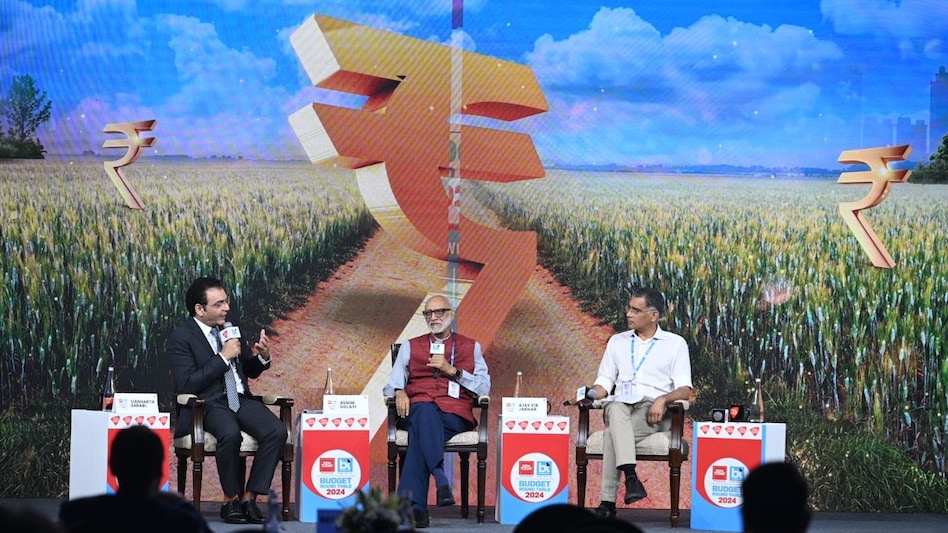 Ashok Gulati of Indian Council for Research on International Economic Relations and Ajay Vir Jakhar, Chairman, Bharat Krishak Samaj, at India Today-Business Today Budget Round Table 2024.
Ashok Gulati of Indian Council for Research on International Economic Relations and Ajay Vir Jakhar, Chairman, Bharat Krishak Samaj, at India Today-Business Today Budget Round Table 2024.
 Ashok Gulati of Indian Council for Research on International Economic Relations and Ajay Vir Jakhar, Chairman, Bharat Krishak Samaj, at India Today-Business Today Budget Round Table 2024.
Ashok Gulati of Indian Council for Research on International Economic Relations and Ajay Vir Jakhar, Chairman, Bharat Krishak Samaj, at India Today-Business Today Budget Round Table 2024.The government’s union budget for 2024-25, aimed at enhancing agricultural productivity and rural infrastructure, is facing criticism from various experts and stakeholders. They argue that the proposed measures may not fully address the challenges in India’s agricultural sector.
Ashok Gulati, Professor at the Indian Council for Research on International Economic Relations, and Ajay Vir Jakhar, Chairman of Bharat Krishak Samaj, shared their views during a session titled “Path To Kisaan Kalyan” at the India Today-Business Today Budget Round Table 2024 held on Saturday.
The Uninon Budget includes an increase in funding for the Pradhan Mantri Kisan Samman Nidhi (PM-Kisan) scheme, which provides direct financial aid to farmers. However, some view this increase as insufficient. Ashok Gulati, an agricultural economist and former Chairman of the Commission for Agricultural Costs and Prices, voiced concern about the limited increase. “The additional funds for the PM-Kisan scheme are a step in the right direction but may not be enough to address the sector’s needs,” Gulati said. “The scheme needs more substantial funding to have an impact,” he added.
Gulati stated that the economy is growing steadily, with an expected growth rate of around 7% this year, following last year’s 8.2%. However, the agriculture sector grew by only 1.4% last year. Over the past decade, agriculture’s average annual growth rate has been about 3.7%, with the Modi administration averaging around 3.5% compared to 3.0% during Manmohan Singh’s tenure. Increasing volatility in agriculture is attributed to climate change.
As discussions around boosting demand to support manufactured products continue, the challenges of demand creation persist. One policy under scrutiny is the PM-Kisan scheme, which has provided ₹6000 annually to farmers for the past five years. Due to inflation, this amount has effectively decreased by at least 25%. With rural per capita monthly consumption at ₹3773, an average household’s monthly expenses are around ₹20,000 when considering inflation and potential savings, Gulati said.
Gulati pointed out the shifting priorities of rural youth. Increasingly, they are leaving agriculture for low-paid, urban jobs due to stagnating income growth in agriculture, which has averaged about 3.5% annually over the past two decades. Government policies of keeping farm output prices low to control inflation also significantly affect farmers’ income, he said.
The PM-Kisan scheme, while important, falls short in addressing the agricultural sector’s needs. “The annual increase in its budget isn’t substantial enough to make a significant difference,” said Gulati. The sector’s challenges, including rising input costs and stagnant productivity, require more comprehensive financial intervention. Jakhar, a farmer and agricultural consultant, shared these concerns. He emphasised the need for systemic reforms beyond financial aid, including improving market access, managing input costs, and promoting crop diversification. “Current measures do not provide long-term solutions,” Jakhar stated, critiquing the budget’s focus on price controls and subsidies. He called for a national farm policy that integrates these measures with structural reforms.
Jakhar criticised food price caps, such as those on onions and wheat, which disadvantage farmers. Export bans on these commodities can lead to significant losses for farmers, suggesting that the government should consider direct benefit transfers or food coupons to support consumers instead of relying solely on price controls.
Another issue is rural infrastructure development discussed during the session. Although the budget includes investments in roads, irrigation, and storage facilities, experts believe these are insufficient on their own. “Improving rural infrastructure must be part of a broader strategy,” Jakhar said, advocating for technological advancements and better market access to support sustainable agricultural growth.